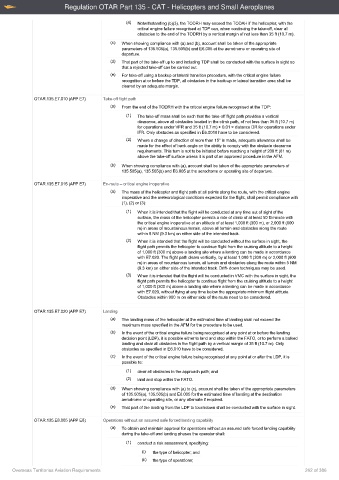Page 262 - Overseas Territories Aviation Requirements Consolidated - Total AOC
P. 262
Regulation OTAR Part 135 - CAT - Helicopters and Small Aeroplanes
(4) Notwithstanding (b)(3), the TODRH may exceed the TODAH if the helicopter, with the
critical engine failure recognised at TDP can, when continuing the take-off, clear all
obstacles to the end of the TODRH by a vertical margin of not less than 35 ft (10.7 m).
(c) When showing compliance with (a) and (b), account shall be taken of the appropriate
parameters of 135.505(a), 135.505(b) and E6.005 at the aerodrome or operating site of
departure.
(d) That part of the take-off up to and including TDP shall be conducted with the surface in sight so
that a rejected take-off can be carried out.
(e) For take-off using a backup or lateral transition procedure, with the critical engine failure
recognition at or before the TDP, all obstacles in the back-up or lateral transition area shall be
cleared by an adequate margin.
OTAR.135.E7.010 (APP E7) Take-off flight path
(a) From the end of the TODRH with the critical engine failure recognised at the TDP:
(1) The take-off mass shall be such that the take-off flight path provides a vertical
clearance, above all obstacles located in the climb path, of not less than 35 ft (10.7 m)
for operations under VFR and 35 ft (10.7 m) + 0.01 × distance DR for operations under
IFR. Only obstacles as specified in E6.0010 have to be considered.
(2) Where a change of direction of more than 15° is made, adequate allowance shall be
made for the effect of bank angle on the ability to comply with the obstacle clearance
requirements. This turn is not to be initiated before reaching a height of 200 ft (61 m)
above the take-off surface unless it is part of an approved procedure in the AFM.
(b) When showing compliance with (a), account shall be taken of the appropriate parameters of
135.505(a), 135.505(b) and E6.005 at the aerodrome or operating site of departure.
OTAR.135.E7.015 (APP E7) En-route – critical engine inoperative
(a) The mass of the helicopter and flight path at all points along the route, with the critical engine
inoperative and the meteorological conditions expected for the flight, shall permit compliance with
(1), (2) or (3):
(1) When it is intended that the flight will be conducted at any time out of sight of the
surface, the mass of the helicopter permits a rate of climb of at least 50 ft/minute with
the critical engine inoperative at an altitude of at least 1,000 ft (300 m), or 2,000 ft (600
m) in areas of mountainous terrain, above all terrain and obstacles along the route
within 5 NM (9.3 km) on either side of the intended track.
(2) When it is intended that the flight will be conducted without the surface in sight, the
flight path permits the helicopter to continue flight from the cruising altitude to a height
of 1,000 ft (300 m) above a landing site where a landing can be made in accordance
with E7.020. The flight path clears vertically, by at least 1,000 ft (300 m) or 2,000 ft (600
m) in areas of mountainous terrain, all terrain and obstacles along the route within 5 NM
(9.3 km) on either side of the intended track. Drift- down techniques may be used.
(3) When it is intended that the flight will be conducted in VMC with the surface in sight, the
flight path permits the helicopter to continue flight from the cruising altitude to a height
of 1,000 ft (300 m) above a landing site where a landing can be made in accordance
with E7.020, without flying at any time below the appropriate minimum flight altitude.
Obstacles within 900 m on either side of the route need to be considered.
OTAR.135.E7.020 (APP E7) Landing
(a) The landing mass of the helicopter at the estimated time of landing shall not exceed the
maximum mass specified in the AFM for the procedure to be used.
(b) In the event of the critical engine failure being recognised at any point at or before the landing
decision point (LDP), it is possible either to land and stop within the FATO, or to perform a balked
landing and clear all obstacles in the flight path by a vertical margin of 35 ft (10.7 m). Only
obstacles as specified in E6.010 have to be considered.
(c) In the event of the critical engine failure being recognised at any point at or after the LDP, it is
possible to:
(1) clear all obstacles in the approach path; and
(2) land and stop within the FATO.
(d) When showing compliance with (a) to (c), account shall be taken of the appropriate parameters
of 135.505(a), 135.505(b) and E6.005 for the estimated time of landing at the destination
aerodrome or operating site, or any alternate if required.
(e) That part of the landing from the LDP to touchdown shall be conducted with the surface in sight.
OTAR.135.E8.005 (APP E8) Operations without an assured safe forced landing capability
(a) To obtain and maintain approval for operations without an assured safe forced landing capability
during the take-off and landing phases the operator shall:
(1) conduct a risk assessment, specifying:
(i) the type of helicopter; and
(ii) the type of operations;
Overseas Territories Aviation Requirements 262 of 386

